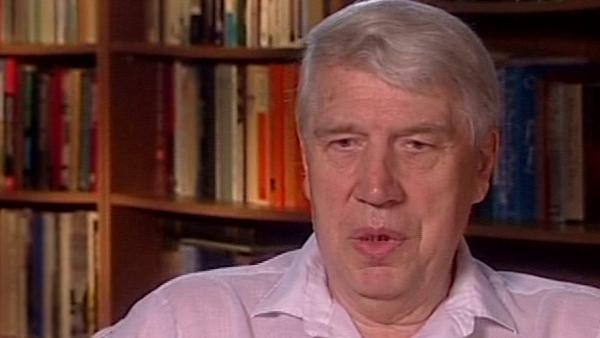NEXT STORY

The Prague school of immunogenetics
RELATED STORIES

NEXT STORY

The Prague school of immunogenetics
RELATED STORIES


|
Views | Duration | |
|---|---|---|---|
| 41. Realising I could be blackmailed by the secret police | 71 | 04:34 | |
| 42. The last time I applied for a job | 83 | 01:34 | |
| 43. Having to decide quickly to leave Czechoslovakia | 83 | 02:37 | |
| 44. Unable to keep my mouth shut | 91 | 02:01 | |
| 45. An explanation of the H2 system | 62 | 03:41 | |
| 46. Gorer's discovery of the four antigens in mice blood groups | 62 | 02:54 | |
| 47. Origin of the name H2 | 59 | 04:27 | |
| 48. The Prague school of immunogenetics | 63 | 03:36 | |
| 49. The H2 Club | 43 | 04:07 | |
| 50. The world suddenly became interested in the H2 system | 40 | 01:52 |


A year later he could show that indeed this antigen II was responsible for the graft rejection. He could show it by genetic experiments where he crossed the strains and followed which segregating individuals would reject the tumor and which not. And at the same time he typed them for antigen II and he found the perfect correlation. In addition he realized that the mice that rejected the tumor had antibodies in their blood and the antibodies was against the antigen II. So it was clear that the same antigen has two faces. One, it induces antibodies, which then detect it on the red blood cells and it induces immune response by whatever mechanism... that was not known, how the tumor is rejected. But by whatever mechanism destroys the tumor so the antigen must be present also on the tumor cells. The tumor cells were derived probably from the epithelial cells. So it was on the epithelium. Later it could be shown that it was practically everywhere on every cell.
In the meantime, then came war and he couldn't do much. He continued, but very little and he couldn't do much during the war. But renewed his effort after the war and in the meantime in Bar Harbor George Snell, who was originally geneticist by training started a series of experiments trying to find out what were these histocompatibility antigens... these antigens that stimulated the immune system for rejection. And it... there were indications already at that time. There were many of them. It was not one, but a large number. At least 15 or even more. The problem was how to distinguish them, how to separate one from the other because the only thing you knew is when there is a difference in one it's rejected. So you didn't know whether it was one, two or three or... so that... then he developed the idea of devising congenics or called congenic strains by genetic means would differ... would be identical with the exception of one of these histocompatibility antigens. He started and he found out that one of these antigens was very strong in the sense that it very rapidly rejected... caused rejection of the tumors. Then he... I think it was Gorer who contacted George Snell. I don't think it was the other way around, but it allowed that Gorer went to Bar Harbor. They put things together and they showed that what Gorer discovered and what Snell discovered was one and the same thing. So they decided to call it H2 because Snell in the meantime introduced the names H1, 2, 3, 4, 5, 6 for the individual histocompatibility antigens. So it became H2. And then Gorer continued with his work mainly serological. That means he was inducing antibodies and finding out in the different combination of strains and finding out how many different antigens there were and so on. And Snell continued his tumor... mainly tumor transplantation work and only later when Peter Demant joined his laboratory and Marianna Cherry joined him, he also became involved in H2 serology.
Born in 1936, Jan Klein is a Czech-American immunologist who co-founded the modern science of immunogenetics – key to understanding illness and disease. He is the author or co-author of over 560 scientific publications and of seven books including 'Where Do We Come From?' which examines the molecular evolution of humans. He graduated from the Charles University at Prague in 1955, and received his MS in Botany from the same school in 1958. From 1977 to his retirement in 2004, he was the Director of the Max Planck Institute for Biology at Tübingen, Germany.
Title: Origin of the name H2
Listeners: Colm O'hUigin
Colm O'hUigin is a senior staff scientist at the US National Cancer Institute. He received his BA, MSc and PhD at the Genetics Department of Trinity College, Dublin where he later returned as a lecturer. He has held appointments at the Center for Population and Demographic Genetics, UT Houston, and at the University of Cambridge. As an EMBO fellow, he moved in 1990 to the Max Planck Institute for Biology in Tübingen, Germany to work with Jan Klein and lead a research group studying the evolutionary origins of immune molecules, of teeth, trypanosomes and of species.
Tags: H2 system, antigens, histocompatibility antigens, George Davis Snell, Peter Alfred Gorer, Peter Demant, Marianna Cherry
Duration: 4 minutes, 27 seconds
Date story recorded: August 2005
Date story went live: 24 January 2008